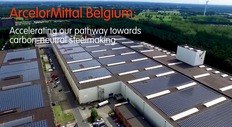- ArcelorMittal invested $30 million in LanzaTech through its XCarb™ innovation fund.
- The Carbalyst® plant in Ghent, Belgium, is expected to be commissioned by the end of 2022.
- The plant will reduce CO2 emissions by 125,000 tonnes annually and produce 80 million liters of bio-ethanol.
- Previous XCarb™ investments include $10 million in Heliogen and $25 million in Form Energy.

Investment and Partnership Expansion
ArcelorMittal has invested $30 million in carbon recycling company LanzaTech through its XCarb™ innovation fund. This marks the fourth investment by the fund since its inception in March 2021, further strengthening the partnership that began in 2015.
Carbalyst® Plant in Ghent
The €180 million Carbalyst® plant, also known as the Steelanol project, is under construction in Ghent, Belgium, with commissioning expected by the end of 2022. The project has received funding from the European Union’s Horizon 2020 program and the European Investment Bank.
Environmental Impact
Using LanzaTech’s gas fermentation technology, the plant will capture carbon-rich waste gases from the steelmaking process and convert them into sustainable fuels and chemicals. This will reduce CO2 emissions by 125,000 tonnes annually and produce 80 million liters of bio-ethanol, which can be blended with traditional gasoline for use as a low-carbon alternative fuel in the transport sector.
Future Developments
LanzaTech is also working on technology to convert captured emissions into various chemical building blocks for materials such as textiles, rubber, and packaging. This aligns with ArcelorMittal’s broader efforts to decarbonize and innovate within the industry.
Previous Investments
Previous investments by the XCarb™ innovation fund include $10 million in renewable energy technology company Heliogen, $25 million in Form Energy for low-cost iron-air battery storage technology, and a $100 million commitment over five years to Breakthrough Energy’s Catalyst program, founded by Bill Gates to scale technologies needed to achieve net-zero emissions by 2050.

